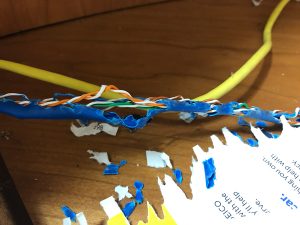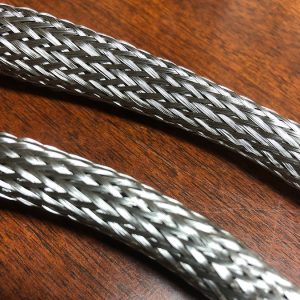 If you have parrots, you are probably well aware of their penchant for biting through cables, and you have probably already discovered that it only takes a few moments of inattention on your part before you’re dealing with the aftermath of a cable attack — the power to all the electronics on the other end of an outlet has been cut off, or you’re online again spending absurd amounts of money replacing laptop power cables. I don’t understand what’s so appealing about a few strands of wire wrapped in plastic, and it is not at all good for them to be chewing on bare metal, especially when current is involved!
If you have parrots, you are probably well aware of their penchant for biting through cables, and you have probably already discovered that it only takes a few moments of inattention on your part before you’re dealing with the aftermath of a cable attack — the power to all the electronics on the other end of an outlet has been cut off, or you’re online again spending absurd amounts of money replacing laptop power cables. I don’t understand what’s so appealing about a few strands of wire wrapped in plastic, and it is not at all good for them to be chewing on bare metal, especially when current is involved!
In spite of the danger, I don’t think that anything will convince a parrot not to go after cables, so physical protection is the best way to protect both bird and cable. If you’re living a lifestyle where your bird is inevitably in dangerous proximity to your electronics, you may find this simple way to protect your cables useful.

 This is steel weave cable wrap. It’s designed to protect cables of varying types from situations where there is potential damage from friction. It comes in multiple widths and lengths, and is easy to order online. I chose the .5 inch so that it would be able to accommodate the ends of my laptop cables. It does expand considerably, so I probably could have used .25 inch just as successfully. The steel weave can be cut with regular scissors, although you may need to stretch it out and flatten it a little so that the scissors are only cutting through a few strands of wire at a time. It is fairly easy to thread your cables through the steel weave, but you will need to sort of expand and inch-worm the sleeve as you pull the cable end through until you get to the other side. You can use multiple methods to close up the ends, which is very important because the bare wire ends are sharp, because you want it to stay in place, and because you don’t want the whole thing to fray or poke your bird’s eye out. You want to avoid leaving a gap between whatever connector is on the end of your cable and the steel protection since any gap in the protection is an opportunity for destruction by a sharp beak. Electrical tape is an okay method, but not ideal. Heat shrink plastic cable sleeves are one nice solution. You can also use a small amount of plastic tubing as a sleeve around the end of the cable and the steel and to be really safe, you can fill the end with silicone. (If you use silicone sealant, you need to apply and allow it to set well away from your bird. You are not going to want your bird exposed to those fumes. It is safe after it has set completely, which takes about 24 hours.)
This is steel weave cable wrap. It’s designed to protect cables of varying types from situations where there is potential damage from friction. It comes in multiple widths and lengths, and is easy to order online. I chose the .5 inch so that it would be able to accommodate the ends of my laptop cables. It does expand considerably, so I probably could have used .25 inch just as successfully. The steel weave can be cut with regular scissors, although you may need to stretch it out and flatten it a little so that the scissors are only cutting through a few strands of wire at a time. It is fairly easy to thread your cables through the steel weave, but you will need to sort of expand and inch-worm the sleeve as you pull the cable end through until you get to the other side. You can use multiple methods to close up the ends, which is very important because the bare wire ends are sharp, because you want it to stay in place, and because you don’t want the whole thing to fray or poke your bird’s eye out. You want to avoid leaving a gap between whatever connector is on the end of your cable and the steel protection since any gap in the protection is an opportunity for destruction by a sharp beak. Electrical tape is an okay method, but not ideal. Heat shrink plastic cable sleeves are one nice solution. You can also use a small amount of plastic tubing as a sleeve around the end of the cable and the steel and to be really safe, you can fill the end with silicone. (If you use silicone sealant, you need to apply and allow it to set well away from your bird. You are not going to want your bird exposed to those fumes. It is safe after it has set completely, which takes about 24 hours.)
 This may or may not be a plus, but being a Goffin’s Cockatoo, Peach was initially terrified by the steel cable protector and wouldn’t come near it. But after a little while she became a little more comfortable and curious and tested it out with her beak. There’s no way she’s getting through that steel, but she doesn’t seem to have any attraction to it in the first place, so it works on multiple levels. I haven’t been able to test this method on larger beaks than hers, but I am confident that it would protect wires against even the largest and toughest beaks.
This may or may not be a plus, but being a Goffin’s Cockatoo, Peach was initially terrified by the steel cable protector and wouldn’t come near it. But after a little while she became a little more comfortable and curious and tested it out with her beak. There’s no way she’s getting through that steel, but she doesn’t seem to have any attraction to it in the first place, so it works on multiple levels. I haven’t been able to test this method on larger beaks than hers, but I am confident that it would protect wires against even the largest and toughest beaks.
Cost of this cable protection system is variable, depending on how many feet you need to cover and what method of end caps you choose to make, but it is not expensive, and it is considerable less expensive than buying a new MacBook Pro power cable every few months!
You can also use steel conduit, but it’s really bulky.

